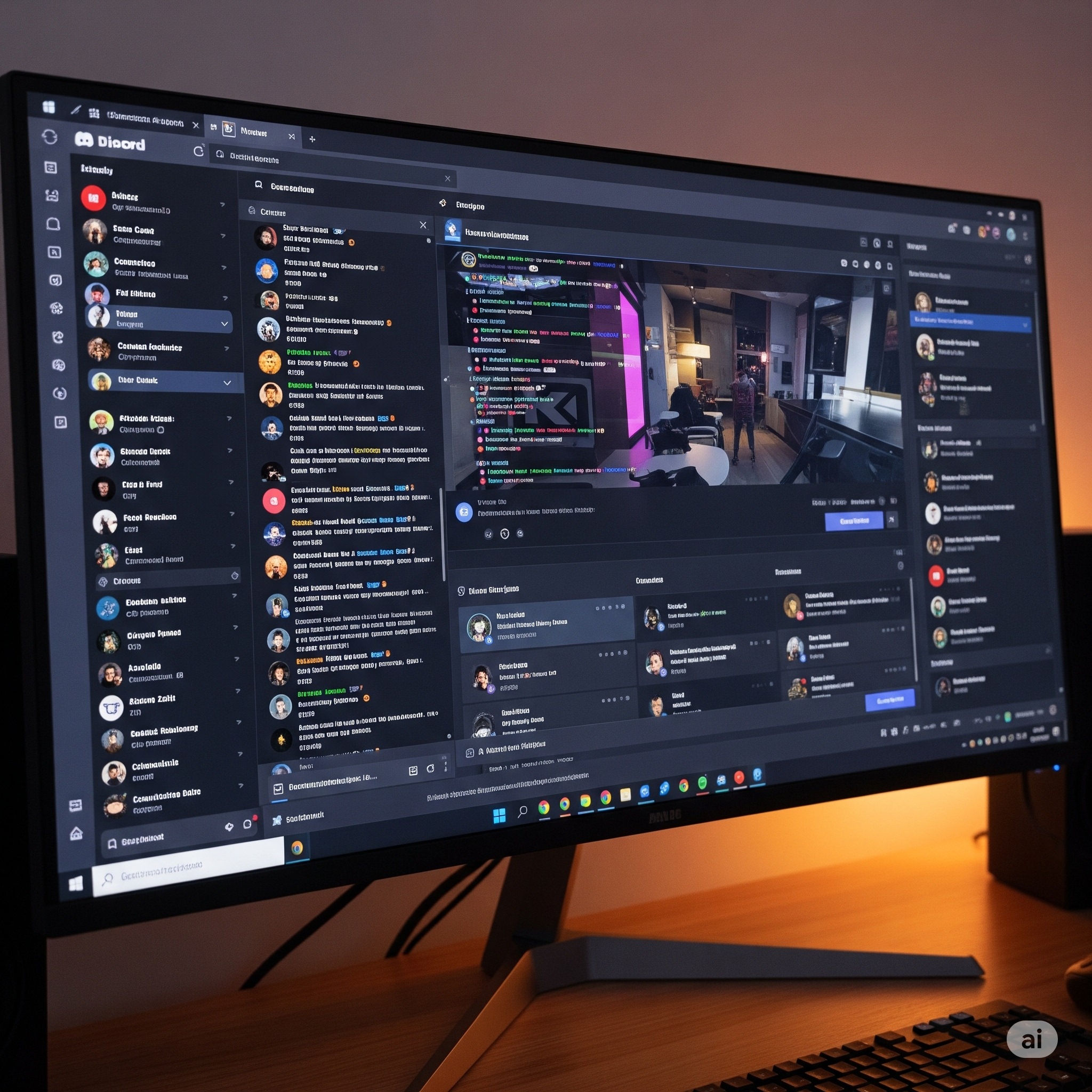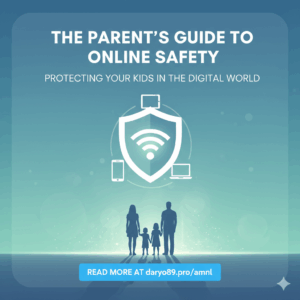I. Introduction: The Strategic Imperative of Discord for Streamers
Discord has emerged as an indispensable platform for content creators, particularly within the dynamic spheres of streaming and gaming. It transcends traditional social media, offering a versatile and direct communication hub that fosters deep connections between creators and their audiences. Unlike platforms riddled with advertisements, Discord provides an ad-free environment, allowing for genuine, uninterrupted interaction. This unique characteristic enables streamers to cultivate intimate, engaged communities, regardless of their audience size, transforming passive viewers into active participants and loyal advocates.
The platform’s robust feature set, encompassing text, voice, and video communication, alongside customizable channels, roles, and integrations, makes it an ideal ecosystem for community building and real-time engagement. For streamers, Discord serves as a central location where fans can receive instant updates, interact with the creator and each other, participate in exclusive events, and feel a profound sense of belonging. This guide, aligned with daryo89.pro’s “Discord Setup” and “Streamer Support” services, aims to equip streamers with the knowledge and strategies necessary to build and manage a thriving Discord community, optimizing their gaming and streaming presence.
II. Foundational Setup: Laying the Groundwork for Your Community
Establishing a Discord server is a straightforward process, yet the initial setup lays the critical groundwork for a successful community. The fundamental steps involve creating the server itself and then enabling its community features to unlock advanced functionalities.
Creating Your Server
The first step involves selecting a server name that accurately reflects the streamer’s brand or community identity. This name should be intuitive and memorable, immediately conveying the server’s purpose to potential members. Following the naming, configuring the server icon is essential; a 512×512 pixel image is typically recommended to represent the brand visually. These initial settings form the very foundation of the Discord server, serving as the digital home for the burgeoning community.
Enabling Community Features
To unlock Discord’s full suite of community management tools, it is imperative to enable the “Community Server” feature. This is achieved by navigating to the Server Settings, then selecting “Community Overview,” and finally activating the feature. Activating the Community feature is a pivotal step, as it grants access to additional channel types such as Forums for organized discussions, Stages for hosting events with an audience, and dedicated Announcements channels, all of which are invaluable for a dynamic streaming community. This activation transforms a basic Discord server into a powerful community hub, equipped with the necessary infrastructure for growth and engagement.
III. Structuring Your Server: Optimal Channels and Categories
A well-structured Discord server is paramount for user experience, ensuring that members can easily navigate and find relevant conversations. This involves thoughtful channel design and strategic categorization.
Strategic Channel Design
Effective channel design begins with a clear understanding of the target audience: their interests, preferred discussion topics, and how they wish to interact. Initially, it is advisable to commence with a limited set of essential channels, such as
#welcome, #rules, #announcements, #general, #support, and #feedback. These foundational channels are crucial for setting the initial tone and providing vital information for new members, preventing them from feeling lost upon joining.
This approach, where a server starts with a few essential channels before gradually expanding, functions as a user experience funnel. When new users join, presenting them with a multitude of channels can be overwhelming and disorienting, creating a significant point of friction. By contrast, starting with a narrow entry point of fundamental channels provides necessary information and a general space to begin. As users become more comfortable, they naturally seek out more specific interests. The gradual introduction of new channels, guided by observing actual community needs , ensures that additions are relevant and utilized, preventing clutter. This streamlined entry process guides new members smoothly into the community, reduces their cognitive load, and significantly increases the likelihood of them finding pertinent conversations. This positive initial experience directly contributes to higher engagement rates and improved long-term member retention, as users feel valued and easily integrated.
Essential Text Channels for Streamers
For a streaming and gaming community, a diverse range of text channels is necessary to cater to various interactions:
- Information Hub:
#welcome: This channel serves as the digital greeter, setting the server’s tone and providing initial orientation. While automated bots can welcome new members, encouraging personal greetings from existing community members fosters a warmer, more inclusive environment.#rules: This non-negotiable channel clearly outlines server guidelines and expectations, which is critical for maintaining a positive and respectful atmosphere.#announcements: The primary channel for broadcasting critical updates, event notifications, and important news. For streamers who focus on multiple games or content types, creating distinct announcement channels, such as#retail-announcementsor#wotlk-announcements, can provide tailored updates without overwhelming members with irrelevant information.#support/#tech-support: A dedicated space for members to ask questions, seek help, and troubleshoot issues. This can be augmented with channels like#my-setupsor#setup-recommendationswhere members can share their gaming rigs and hardware advice, fostering peer-to-peer assistance.#feedback: An invaluable channel for members to share suggestions and ideas for server improvement. Actively soliciting and responding to feedback demonstrates that members’ input is valued, cultivating a sense of ownership and investment in the community.
- Engagement & Community:
#general/#chit-chat/#irl-life: A versatile, catch-all channel for casual conversations, off-topic discussions, and sharing aspects of daily life.#game-discussion/#game-recommendations: Central to a gaming community, this channel allows members to share and discuss games, strategies, and tips.#live-now/#stream-notifications: Essential for streamers, these channels provide automated alerts when the streamer goes live on their chosen platforms.#screenshot-gallery/#clips/#media: A vibrant space for members to share in-game screenshots, video clips, or links to YouTube videos. These are excellent conversation starters and showcases of community talent.#fan-art/#show-your-work: Encourages and showcases fan-created art or personal creative projects, fostering a sense of community pride and celebrating talent.#memes: A lighthearted and popular channel dedicated to sharing and collecting memes, adding flavor and fun to the server atmosphere.#giveaway-center: A hub for community giveaways, a powerful tool for rewarding members and attracting new ones.#lfg(Looking for Group) /#multiplayer-meetups: Facilitates members finding gaming partners for co-op or PvP sessions, directly enhancing the gaming experience and fostering collaboration.#community-events/#game-night-plans: Channels dedicated to announcing and organizing upcoming events and meetups, encouraging participation and real-time interaction.#qotd(Question of the Day): A simple yet effective channel to spark daily discussions or serve as a fun icebreaker, maintaining consistent engagement.
The inclusion of specialized channels serves as a powerful mechanism for driving niche engagement. If all discussions were confined to a few broad channels, specific interests would become diluted, and conversations would be noisy and difficult to follow. Members interested in a particular niche might feel their contributions are lost or irrelevant. By contrast, dedicated channels for specific topics—such as a particular game, a type of content, or a specific activity—allow members to self-select into areas that genuinely interest them. This creates smaller, more focused communities within the larger server. The discussions in these niche channels become more targeted, meaningful, and engaging for the participants, fostering a stronger sense of belonging because individuals are interacting with others who share their precise interests. This deepens engagement beyond superficial chat. When members find a dedicated space where their specific passions are catered to, they are more likely to remain active and invested in the server. This transforms the server from a generic gathering place into a tailored experience for each user, directly contributing to higher quality engagement and improved long-term retention.
Voice Channels: The Hub of Real-Time Interaction
Voice channels are the cornerstone of real-time interaction on Discord, enabling direct voice communication that is indispensable for gaming, collaborative activities, and live events. Streamers should consider a variety of voice channels to cater to different needs:
🔊 General Voice for casual conversations, 🔊 Music Room for shared listening experiences, 🔊 Study Room for quiet, focused work, 🔊 Game Chat for in-game communication during multiplayer sessions, and 🔊 Private Calls for exclusive, invite-only discussions.
Discord’s “Go Live” feature is a powerful tool for streamers, allowing users to screen share any application window, their entire screen, or specific video games directly within voice channels. This feature supports up to 50 concurrent participants, making it ideal for interactive sessions, co-working, or small group watch parties.
Organizing with Categories for Seamless Navigation
Utilizing categories is an exceptionally effective strategy for organizing channels, grouping related ones under clear, intuitive headings such as “General,” “Support,” or “Gaming”. This hierarchical structure significantly enhances server navigability, making it easier for members to locate and participate in conversations that align with their interests.
As with channels, it is advisable to start simply with fundamental categories like “General” and “Announcements,” expanding gradually as the community’s needs and interests become more defined. This approach to categories functions as a critical element of information architecture for scalability. Without categories, a server with many channels quickly becomes a long, unmanageable list, posing a significant barrier to entry and ongoing engagement for users. Categories impose a logical hierarchy, grouping related content, which is a core principle of effective information architecture, making complex systems easier to understand and use. Users can quickly scan categories to find their area of interest (e.g., “Gaming” or “Support”) and then drill down into specific channels. This reduces cognitive load and prevents users from feeling overwhelmed by the sheer volume of channels. As a streamer’s community grows and more channels are added, a well-defined category structure ensures that the server remains organized and user-friendly. Without this framework, growth would inevitably lead to chaos and a decline in user experience, ultimately hindering retention. It is the framework that allows the server to scale gracefully.
Table: Essential Discord Channels for Streamers
| Category Example | Channel Example | Purpose |
| Welcome & Info | #welcome | Greet new members, server introduction |
IV. Empowering Your Community: Roles and Permissions
Discord’s role and permission system is a cornerstone of effective community management, enabling precise control over member interactions and server security.
Understanding Discord’s Role Hierarchy
Discord’s sophisticated role system is fundamental for effective community management, allowing creators to precisely manage fan interaction levels and assign custom permissions. This system operates on a crucial top-down hierarchy, where a role’s position in the list dictates its power. Members holding a higher-positioned role can only affect users with roles situated lower than their own highest role.
The @everyone role is a foundational element, acting as the default template for all new roles. It is a best practice to configure this role following the “principle of least privilege,” meaning it should only grant basic viewing and interaction permissions, strictly avoiding any management capabilities. This minimizes potential risks and ensures a secure baseline for all server members.
This hierarchical structure is more than just an organizational tool; it functions as a robust security and delegation framework. It prevents lower-level roles, such as a new moderator, from accidentally or maliciously altering or impacting higher-level roles, such as an administrator or the streamer themselves. This is a critical safeguard against unauthorized access or server disruption. Furthermore, as a streamer’s community grows, it becomes impractical for them to manage every aspect personally. The hierarchy allows for the strategic delegation of specific responsibilities—like channel management or muting members—to trusted moderators without granting them full administrative control. Each role can be given precise permissions relevant to its responsibilities, avoiding over-permissioning. By understanding and leveraging this framework, streamers can safely empower their community members and moderation team, ensuring smooth operations and maintaining server integrity as the community scales, preventing burnout for the streamer, and fostering a secure environment.
Creating Custom Roles: Members, Moderators, VIPs, and Subscribers
The ability to assign custom roles to various segments of the community—including general members, dedicated moderators, valued VIPs, and loyal subscribers—is essential for maintaining order and ensuring smooth server operations. These roles are not merely titles; they are powerful tools for understanding the different user profiles within the community and assigning tailored permissions.
- Role Colors: A simple yet effective visual cue, Discord’s role colors allow for quick identification of members’ permissions and status within chat and member lists. Members will display the color of their highest-positioned role, making the role hierarchy visually apparent. Role positions can be easily adjusted by dragging them up or down in the roles list, influencing their prominence.
- Subscriber Roles (Twitch & YouTube): For Twitch Partners and Affiliates, Discord offers seamless integration that automatically syncs Twitch subscribers to designated roles within the server. Upon integration, roles such as “Twitch Subscriber,” “Twitch Subscriber: Tier 1,” “Twitch Subscriber: Tier 2,” and “Twitch Subscriber: Tier 3” are auto-created. These roles can be renamed, and their permissions and colors can be fully customized. This integration also allows Twitch subscribers to bypass server rule screening and, importantly, enables them to use Twitch emotes globally within Discord. Similarly, YouTube Partners with Channel Memberships enabled can integrate their YouTube channel with Discord, which automatically creates roles for their members (e.g., “YouTube Member,” with additional roles for each membership tier like “YouTube Member: Plus”). These roles also offer customization options for names, permissions, and colors. This automated assignment of subscriber roles functions as a powerful monetization and retention lever. The automation is not just about saving manual effort; it creates a direct, tangible link between a viewer’s financial support on a streaming platform and their status and benefits within the Discord community. By granting exclusive roles, access to private channels , or global emote usage to paying subscribers, streamers provide immediate, visible value for their patronage. This transforms a subscription from a simple transaction into a membership with exclusive perks and a higher status within the community. This system incentivizes viewers to subscribe or become members, knowing they will unlock a deeper, more personalized experience on Discord. For existing subscribers, it reinforces the value of their ongoing support, directly contributing to higher retention rates. This creates a powerful feedback loop: support the streamer, gain exclusive community benefits, feel more connected, and continue supporting. Therefore, automated subscriber roles are a critical component that seamlessly bridges a streamer’s revenue streams with their community engagement efforts, creating a compelling ecosystem that rewards loyalty and encourages continued financial support.
Assigning Permissions: A Deep Dive into Access Control
Discord’s permission system is incredibly granular, allowing for precise access control at multiple levels: server-wide, category-specific, and channel-specific. Crucially, channel-level overrides will always take precedence over category or server permissions for that specific channel.
- Recommended General Permissions for Most Server Members (@everyone): When configuring the
@everyonerole, it is essential to adhere to the principle of least privilege. Essential permissions includeView Channels,Send Messages,Create Public Threads,Send Messages in Threads,Create Invite(allowing members to invite others),Change Nickname(allowing personalization),Use Application Commands(for bot interaction), andUse Activities(for shared experiences). - Recommended Voice Channel Permissions for Most Server Members: For voice channels, ensure members have
Connect(to join),Speak(to talk), andVideo(to use webcams or screen share). Optional permissions likeUse External Soundscan be initially disabled and enabled later if the community desires, creating a positive “new permission” experience when introduced.Use Voice ActivityandSet Voice Channel Statusalso enhance the voice experience. - Moderator Permissions: Assigning permissions to the moderation team requires careful consideration. Key permissions often include
Timeout Members(to temporarily restrict users),Manage Nicknames(to correct inappropriate names),Move Members(to relocate users between voice channels),Create Events, andManage Events. It is vital to remember that moderators can only adjust roles or permissions that are ranked lower than their own highest role. - Administrator Permission: This is the most potent role permission available, granting all permissions and bypassing all channel restrictions. Due to its immense power, the Administrator role should be assigned with extreme caution and only to the most trusted individuals.
The granular nature of Discord’s permissions facilitates a scalable trust model. A simple “admin versus user” model is unsustainable for growing communities, as it either overburdens the administrator or creates security vulnerabilities by over-permissioning non-admins. The layered permission system allows for a nuanced distribution of trust. New members begin with minimal permissions (@everyone with least privilege). As members demonstrate trustworthiness and engagement, they can be given more specific responsibilities—for example, a “community helper” role with permission to answer questions in a support channel, but not to moderate general chat. This system empowers community members and moderators with precisely the tools they need to contribute, without granting excessive power. It significantly reduces the risk of accidental or malicious actions, fostering a safer and more organized environment. It also creates pathways for community members to “level up” and take on more responsibility, deepening their investment. Therefore, granular permissions are crucial for building a secure and self-sustaining community, enabling streamers to delegate tasks effectively, distribute moderation responsibilities, and cultivate a sense of ownership among trusted members, all while maintaining strict control over sensitive server functions. This is essential for long-term community health and growth.
Role-Exclusive Channels for Special Access
One of the most effective ways to create private or exclusive spaces within a server is by making channels “role-exclusive”. When a channel is designated as private, Discord automatically removes the “View Channel” permission from the
@everyone role. This allows for precise granting of access only to specific roles, such as VIPs, paying subscribers, or the moderation team. This feature is ideal for creating subscriber-only lounges, moderator discussion channels, or exclusive content drops for specific tiers of supporters, adding significant value to membership.
Table: Key Discord Permissions for Roles
| Role Type | Key Text Channel Permissions | Key Voice Channel Permissions | Key Server Management Permissions | Best Practice / Note |
| @everyone (Default) | View Channels, Send Messages, Create Public Threads, Send Messages in Threads | Connect, Speak, Video, Use Voice Activity | Change Nickname, Use Application Commands, Use Activities | Least Privilege: Basic access for all new members. |
| Member | As @everyone, plus: Send Messages in Threads, Create Invite | As @everyone | Change Nickname, Use Application Commands, Use Activities | Standard user interaction and participation. |
| Moderator | As Member, plus: Manage Messages, Kick Members, Ban Members (limited) | As Member, plus: Mute Members, Deafen Members, Move Members | Timeout Members, Manage Nicknames, Create Events, Manage Events, Manage Channels (limited), Manage Roles (limited) | Delegate with caution; focus on community support and enforcement. |
| VIP/Subscriber | As Member, plus: Access to exclusive text channels | As Member, plus: Access to exclusive voice channels | (No additional management permissions typically) | Exclusive content & perks; foster loyalty. |
| Administrator | All text channel permissions | All voice channel permissions | All server management permissions | Ultimate control; assign with extreme caution to only the most trusted. |
V. Welcoming Newcomers: Crafting an Effective Onboarding Experience
A well-designed onboarding process is paramount for a new member’s initial experience and their likelihood of long-term engagement.
Designing a Smooth and Informative Onboarding Process
The primary objectives of a robust onboarding process are twofold: to gain a better understanding of new members’ interests and to clearly inform them about the content and offerings available on the server. A smooth and intuitive onboarding experience makes newcomers feel genuinely welcome and significantly increases their propensity to stay and become active participants. The process should be kept simple, guiding them efficiently through key channels, server rules, and essential features. To streamline and customize this crucial first impression, enabling Discord’s native “Community Onboarding” feature, accessible via Server Settings > Community Onboarding, is highly recommended. This built-in functionality is designed to make the onboarding process more engaging and less daunting.
Leveraging Customization Questions for Personalization
Discord’s Community Onboarding feature empowers server administrators to create custom questions that new members answer upon joining, allowing them to select additional channels and roles tailored to their interests. These onboarding questions should be tailored to the specific community. For a streaming and gaming audience, this could involve asking about their favorite game genres, the streaming platforms they frequent, the types of content they enjoy, or even if they are streamers themselves. Based on their answers, relevant roles can be automatically assigned, or access to specific channels can be granted.
The flexibility exists to choose whether questions “Ask before a member joins” (ideal for critical questions that assign important channels or roles) or to “Allow multiple answers” for broader interest selection. It is always beneficial to use the “Preview” button to test the onboarding flow from a new member’s perspective. It is important to avoid overwhelming new users with too many options or overly lengthy questions and descriptions.
This use of customization questions during onboarding serves as a powerful personalization and segmentation tool. While it clearly functions to “get to know new members better” , its deeper utility extends beyond a simple introduction. By asking about specific interests, such as favorite games or content types, the streamer can automatically segment new members into relevant groups. This prevents new members from being dropped into a large, generic server where they might feel lost or overwhelmed. This segmentation enables immediate personalization of the user experience, as members are automatically shown channels and content directly relevant to their stated interests. This reduces information overload and makes the server feel more tailored and welcoming from the very first interaction. When new members immediately find content and people relevant to their interests, they are far more likely to engage actively and remain within the community. This combats the “daunting” feeling of entering a large server and increases the “stickiness” of the community, directly contributing to higher long-term retention rates.
Default Channels and Role Assignment on Entry
As part of the onboarding setup, carefully select the “Default Channels” that all new members will see immediately upon joining. It is advisable to prioritize channels that are highly active and friendly for new joiners, such as a general chat, polls, giveaways, or forums. Conversely, avoid including channels that may not be immediately useful or relevant for most new members as part of the default set; these can be made accessible later through the customization questions in the onboarding process. This approach ensures a clean and focused initial view, preventing information overload.
Implementing Raid Protection and Security Measures
Discord has significantly enhanced its built-in security infrastructure, incorporating multiple layers of Raid and Spam protection, alongside robust AutoModerator functions. These features are designed to be easily configurable, often allowing for a “set once and forget” approach, thereby reducing the previous reliance on third-party safety bots. Once configured, Discord’s backend actively scans and vets each message, attachment, and new member as they join, providing a continuous layer of defense. The platform’s Raid Protection system specifically utilizes machine learning to automatically detect suspicious behavior indicative of an impending join-raid.
A critical best practice is to remove any cumbersome, bot-powered verification steps that might overwhelm or inadvertently lock out well-intentioned new members. Discord’s native Community Onboarding and Raid Protection features provide a more seamless and secure way to grant new members their initial roles and channel access, ensuring a welcoming yet protected environment.
These proactive security measures are not just about preventing malicious actors; they are crucial trust and growth enablers. A server that is visibly safe from spam, raids, and inappropriate content builds immediate trust among legitimate members. They feel secure enough to engage freely and consistently, knowing the environment is protected. This trust is foundational for sustained community activity. Furthermore, removing cumbersome, bot-powered verification steps directly reduces friction for new members joining. If the onboarding process is difficult or confusing due to excessive security hurdles, potential members might abandon the server before even entering. A smooth, secure entry encourages more joins. Therefore, proactive security measures are essential for fostering a positive user experience, which is critical for both retaining existing members and attracting new ones, ultimately supporting the community’s expansion.
VI. Fueling Engagement and Retention: Keeping Your Community Vibrant
Maintaining a vibrant and active Discord community requires continuous effort and strategic engagement.
Consistent Interaction: Daily Prompts, Polls, and Discussions
Consistent engagement and active management are the cornerstones for both attracting new members and, crucially, retaining existing ones. While it demands effort, the rewards in community growth and loyalty are substantial. To keep the community interested and actively participating, it is beneficial to post engaging content regularly. This includes sharing news, updates, initiating discussion topics, and incorporating multimedia content.
Simple yet effective tactics include asking daily questions or running polls. A “Question of the Day” can be a powerful icebreaker, consistently prompting members to chat and share their thoughts. Streamers can also leverage their existing content creation cadence. For instance, sharing audio snippets from an upcoming podcast release can spark discussion, or posting the latest short-form videos and asking the audience what they would like to see more (or less) of. This approach fuels conversation without requiring entirely new content creation efforts.
This consistent, integrated content strategy, particularly by leveraging existing work, functions as a powerful community engagement driver. A server that experiences periods of inactivity will inevitably see members disengage and eventually leave, as people require a consistent reason to return. Streamers already produce a variety of content, such as live streams, videos, and podcasts. The strategic approach involves repurposing this content for Discord engagement rather than creating entirely new, time-consuming material. Sharing snippets, asking for feedback on recent streams, or using stream highlights as discussion prompts are low-effort, high-impact strategies. Daily prompts, polls, or questions provide consistent “return triggers,” ensuring members know there will always be something new to interact with, even when the streamer is not live. This ensures the Discord server remains a vibrant, active space that members actively seek to visit regularly. It fosters a continuous conversation flow, deepening community bonds and significantly improving member retention by making the server an indispensable part of their daily online routine.
Hosting Engaging Events: Watch Parties, Game Nights, AMAs, and Giveaways
To actively encourage participation and inject excitement into the community, it is beneficial to make hosting regular events or contests a practice. Popular and effective event types include organizing “Watch Parties” for shared content consumption or “Community Games” for interactive play sessions. Hosting “Ask Me Anything” (AMA) sessions, featuring the streamer or relevant industry figures, provides direct interaction and unique insights.
Giveaways are a universally appealing method to reward the community and simultaneously attract new members. Digital prizes, such as custom roles, exclusive art from community members, or a month of Discord Nitro, are highly recommended as they avoid logistical complexities associated with physical items.
Utilize Discord’s native event scheduling feature to clearly communicate upcoming activities to the audience. When creating events, be specific about the date, time, location (e.g., a specific voice channel), and what activities will be taking place. Discord automatically adjusts event times to each user’s local timezone, simplifying participation for a global audience.
Strategic event planning serves as a comprehensive community lifecycle management tool. While events are inherently fun, their strategic value extends across the entire community journey. Giveaways are excellent for attracting new members and generating initial buzz. AMAs provide direct access to the streamer, fostering deeper personal connections and a sense of exclusivity for existing members. Watch parties and game nights create shared experiences that strengthen bonds between members. Hosting at least one recurring event series provides a consistent reason for members to return, bolstering retention. Celebrating server milestones or individual member achievements reinforces a positive, supportive atmosphere, making members feel valued. By strategically planning a mix of event types, streamers can continuously engage their audience, from initial attraction through sustained loyalty, ensuring the community remains dynamic and invested.
Promoting Your Server for Growth
Actively promoting the Discord server is crucial for attracting new members and expanding the community’s reach. This requires a multi-faceted approach across various platforms.
Promote the Discord server on social media channels such as Twitter, TikTok, and Reddit by sharing the server’s invite link alongside engaging content related to the community. Regular posts, highlights, events, and updates, coupled with relevant hashtags, can significantly broaden reach and attract potential members interested in the server’s niche. Engaging with followers by responding to comments and messages also encourages them to join.
Collaborating with influencers in the streamer’s niche can be a powerful method for promotion, leveraging their established credibility and loyal following to drive significant increases in new members. Offering exclusive content, such as tutorials, behind-the-scenes looks, or early releases, creates a sense of value and urgency, making potential members feel privileged to access content not available elsewhere.
If eligible, submitting the server to Discord’s discovery program can increase its visibility within the platform. Cross-promotion with other Discord servers, through shoutouts or joint events, can also lead to mutually beneficial membership growth. Offline promotion at events, conferences, or meetups related to the server’s topic, through flyers, business cards, or direct mentions, can attract dedicated members.
This multi-channel promotion strategy acts as a growth multiplier. Relying on a single promotional channel limits reach and potential member acquisition. By diversifying promotion across social media, influencer collaborations, exclusive content offerings, and even offline efforts, streamers can tap into different audience segments and amplify their reach exponentially. Each channel serves as an additional entry point for potential members, increasing the likelihood of discovery and conversion. This integrated approach ensures a steady stream of new members, which, as observed, is itself an important factor for maintaining server activity and adding “flavor to ongoing conversations”. This comprehensive promotional effort is vital for continuous community expansion.
Leveraging Bots and Integrations for Optimization
Discord bots and integrations are powerful tools that automate tasks, enhance engagement, and streamline server management, allowing streamers to focus more on content creation and direct community interaction.
- Custom Bots: Bots like MEE6, Dyno, Carl-bot, and Sx Bot offer a wide range of functionalities. These include sending automated live notifications when a streamer goes live on Twitch or YouTube, managing roles (e.g., reaction roles), welcoming new members, providing advanced moderation tools, running giveaways, and tracking server analytics. Many bots allow for deep customization, enabling them to align with the server’s unique personality and branding.
- Webhooks: Discord Webhooks provide a method to send automated messages and notifications to a Discord text channel via web requests. This is particularly useful for integrating with external services, such as automatically posting news articles, social media updates, or blog updates directly into a Discord channel. Webhooks can also be used to create custom alerts or even simple automated bots. It is crucial to keep webhook URLs confidential and configure appropriate permissions to maintain security.
- Streamer Mode: Discord’s built-in Streamer Mode is a quick and accessible feature designed to hide sensitive or personal information when a streamer is live. This mode can automatically enable when streaming software (like OBS or Xsplit) is running. It protects personal details such as Discord discriminator tags, emails, and stream connections from being inadvertently displayed. It also allows for hiding instant invite links and disabling sounds and notifications, ensuring a professional and private streaming experience. While named “Streamer Mode,” its utility extends to anyone wishing for anonymity during public activities.
The strategic use of automation and integration serves as a significant scalability enabler. As a community grows, manual management of tasks such as notifications, moderation, and member onboarding becomes increasingly time-consuming and prone to error. Bots and webhooks automate these repetitive processes, freeing up the streamer and their moderation team to focus on higher-value interactions, such as direct engagement and content creation. This reduction in manual load allows the server to handle a larger member base without a proportional increase in administrative effort. Furthermore, integrations with streaming platforms ensure that the Discord community is always synchronized with the streamer’s live content, providing immediate value to members. This enhanced functionality and reduced operational overhead are critical for sustaining growth and preventing burnout, ensuring the community can scale effectively.
Effective Moderation and Community Management
Active and effective moderation is indispensable for cultivating a positive, safe, and engaging environment within a Discord community. It is the backbone that upholds server rules and fosters a welcoming atmosphere.
Establishing clear and concise server rules and guidelines is the foundational step. These rules should be fair, enforceable, and explicitly outline acceptable and unacceptable behavior. Involving the community in the rule-making process can ensure that the rules reflect shared values and expectations, fostering a greater sense of adherence. Common rules include being respectful, prohibiting inappropriate language, preventing spamming, disallowing NSFW content outside designated channels, and forbidding advertisements, threats, or the sharing of illegal/pirated content. Discord’s Community Guidelines and Terms of Service should always be upheld.
Creating a welcoming and inclusive environment is key to building a strong and active community. This involves being open to users of all backgrounds, actively promoting diversity, and addressing any instances of discrimination or harassment promptly. Providing channels for new members to introduce themselves and share interests can help them connect and find common ground.
Active listening and responding to feedback are crucial for continuous improvement. This demonstrates that the streamer values their community’s input. Conflict resolution and dealing with difficult members require a clear system, whether it’s a case-by-case approach, an infraction-based system (e.g., “three strikes”), or a points-based structure for rule enforcement. Utilizing Discord’s built-in moderation tools, such as muting, kicking, and banning, is essential for maintaining order.
Empowering a moderation team is vital for managing a growing community. Moderators should be familiar with the server’s code of conduct and community guidelines. They are responsible for enforcing rules, removing inappropriate posts, banning bots, and actively engaging in chat to encourage positive participation. Streamers should set clear expectations for their moderation team, including communication protocols and how to handle various situations. Discord provides automated moderation tools like AutoMod, which can scan and vet messages, and admins should ensure their moderators know how to report harassment and collect user/message IDs for Discord Trust & Safety.
Effective moderation functions as a culture cultivator and safety net for the community. Without clear rules and active enforcement, a server can quickly devolve into chaos, deterring legitimate members. By establishing a robust moderation framework, streamers create a predictable and safe environment where members feel comfortable expressing themselves and engaging with others. This safety net allows for the free flow of conversation and the development of genuine connections, as members trust that inappropriate behavior will be addressed. Furthermore, a well-managed moderation team allows the streamer to delegate responsibilities, preventing burnout and ensuring consistent oversight. This fosters a positive, safe, and engaging environment, which is fundamental for long-term community health and growth.
Fostering Brand Loyalty and Community Connection
Discord’s core design facilitates direct, meaningful connections, making it an exceptional platform for building brand loyalty. It moves beyond a one-way broadcast channel, becoming an interactive space where genuine community forms around the streamer’s brand.
Consistent engagement is key to building a vibrant community. Streamers do not need to be active 24/7; rather, they should set clear expectations with their community about their participation schedule. Blocking off dedicated “Discord time” or committing to weekly AMA events can manage expectations effectively. Leveraging the moderation team to support the schedule ensures smooth operations even when the streamer is offline.
Inspiring user-generated content (UGC) is a powerful way to increase engagement and build loyalty. Dedicated channels where members can post fan art, share stream highlights, or discuss “hacks” related to the streamer’s content transforms passive consumption into active participation. This UGC also acts as social proof, encouraging other members to engage further.
Offering exclusive promotions, content, or unique roles provides compelling incentives for viewers to join and remain active in the Discord community. This creates a sense of privilege and value for server members, distinguishing the Discord experience from other platforms. Rewarding users with unique roles based on activity or loyalty further encourages participation and deepens their investment in the community.
This focus on community functions as the core of brand loyalty. By providing a dedicated, ad-free space for direct interaction, streamers transform their audience from mere viewers into active participants and loyal advocates. The ability to engage consistently, offer exclusive content, and empower community members fosters a strong sense of belonging and ownership. This direct connection builds trust and rapport, making members feel genuinely valued and heard. This deeper relationship transcends typical viewership, cultivating a highly engaged and loyal community that actively supports the streamer’s brand and contributes to its sustained success.
VII. Conclusion and Recommendations
Mastering Discord for community building is not merely an auxiliary task for streamers; it is a strategic imperative for sustained growth, engagement, and monetization. The platform’s unique architecture provides an unparalleled environment for fostering direct, authentic connections with an audience.
The analysis underscores several critical components for success:
- Structured Foundation: Beginning with a well-organized server, intuitive channels, and logical categories is fundamental. This structured approach, akin to an information architecture, prevents user overwhelm and ensures seamless navigation, which is vital for scalability as the community expands.
- Empowered Roles and Precise Permissions: A robust role hierarchy, coupled with granular permission assignments, is essential for both security and effective delegation. Automated subscriber roles, in particular, serve as a powerful mechanism to convert viewership into tangible community benefits, directly incentivizing financial support and enhancing member retention.
- Engaging Onboarding: A streamlined and personalized onboarding process, leveraging Discord’s native Community Onboarding features and customization questions, is crucial for making new members feel welcome and immediately integrating them into relevant discussions. Proactive security measures, such as Discord’s built-in raid protection, further build trust and reduce friction for new joiners.
- Consistent Engagement and Dynamic Events: Maintaining a vibrant community necessitates a consistent content cadence, often by repurposing existing streaming content. Regular, strategically planned events—from watch parties and game nights to AMAs and giveaways—are key drivers for attracting new members, deepening connections, and ensuring ongoing activity.
- Strategic Promotion and Automation: Multi-channel promotion is vital for growth, amplifying reach across various platforms. The judicious use of Discord bots and webhooks automates routine tasks, freeing up valuable time for streamers and their moderation teams, thereby enabling the community to scale efficiently without increased manual overhead.
- Proactive Moderation: An active and well-defined moderation strategy is the bedrock of a safe and positive community environment. By upholding clear rules and empowering a trusted moderation team, streamers cultivate a culture of respect and engagement, which is paramount for long-term community health.
For daryo89.pro’s clients, these insights translate into actionable recommendations. Streamers should prioritize the initial setup with a clear structural plan, leveraging Discord’s community features. They should meticulously design roles and permissions, paying particular attention to integrating subscriber benefits to reward loyalty. Developing a welcoming onboarding flow that personalizes the new member experience is paramount. Furthermore, streamers must commit to a consistent engagement strategy, regularly hosting diverse events and actively promoting their Discord presence across all their platforms. Finally, investing in and properly configuring moderation tools and bots will ensure the community remains vibrant, safe, and manageable as it grows. By embracing these principles, streamers can transform their Discord servers into thriving ecosystems that not only support their brand but also foster a deeply connected and loyal fanbase.











Add comment
You must be logged in to post a comment.